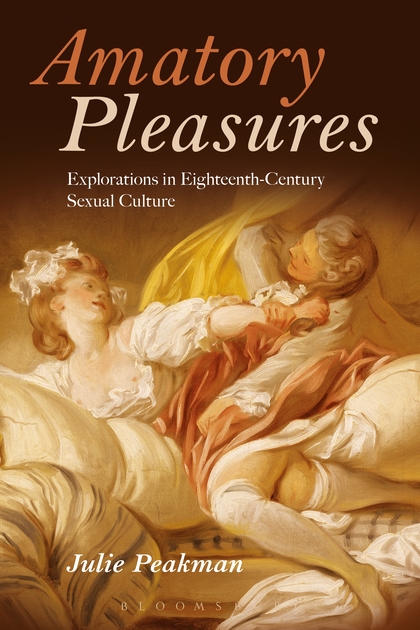
This is part of our special feature The Gender of Power.

When it comes to bodily fluids, blood fetishes, and flagellation, there is a wealth of fascinating information in Julie Peakman’s book, which promises to reveal aspects of eighteenth-century sexual culture that one might expect are difficult to find information about. Whilst sources in which everyday participants describe normative sexual practices are not exactly abundant, Peakman mines statistical data, erotica and pornography, sex manuals and medical treatises for her information. Her acknowledgement that “there was no one coherent attitude to sex in the eighteenth century […] the body was the subject of both scientifically professed fact, imagination and experience in daily life” (147) justifies her use of such seemingly disparate source materials. The book sheds light on various aspects of sexual culture, from gender and sex differences and depictions of the body, to prostitution narratives and anxieties about masturbation, and in doing so, it elucidates interrelations between genres and discourses that we now see as separate: pornography, science, medicine, botany, fiction.
The book is made up of mostly pre-published articles and chapters brought together under three sections: norms and anomalies; erotic women: fact and fiction; and exploring bodies. Efforts have been made to ensure there are not too many crossovers between chapters, and indeed, many of them speak to one another in fruitful ways. The chapters contain a mix of very broad brushstrokes and miniature work. The former will be more pleasing to students and readers trying to make sense of the period as a whole, whilst the latter will interest scholars of the period, fleshing out understandings of particular sexual acts or charting recurrent ideas, such as, for example, the fascination with blood in scenes of defloration.
The first three chapters establish sexual norms and deviations. The scope of the first chapter is enormous, encompassing Europe, European colonies and East Asia to consider sex, marriage, prostitution and homosexuality throughout the long eighteenth century. Peakman claims that “[w]hile it has been helpful to identify nuances in the past, it is essential to take a broader sweep if longer term trends are to be identified” ( 4). However, the chapters that follow are certainly more interesting when they move away from such expansive narratives and avoid the tendency to catalogue rather than to unpack material. Chapter two plays close attention to the ways that historically contingent “perversions” are constructed, although, again, the scope is large, indicative of the fact that the chapter originally formed the introduction to a book about sexual perversions between 1650 and 1890. Chapter three is the only chapter made up of entirely new material in the collection. It examines the culture of blaming and shaming that emerged in print culture, arguing against the Foucauldian notion of internalized discipline, and instead considering how print culture functioned in producing and policing behavior.
Part two examines depictions of sexual women, both fictional and real. Chapter four reads male-authored biographies alongside other contemporary materials about prostitution, whilst chapter five examines the female-authored autobiographies of three courtesans: Margaret Leeson, Hariette Wilson, and Julia Johnstone. Chapter six compares John Cleland’s treatments of sexual initiation and flagellation in Fanny Hill (1748) with those in other erotic works. Chapter seven outlines the roles played by Emma Hamilton and her friend Maria Caroline, Queen of Naples, in political and diplomatic efforts during the Napoleonic Wars, and sits slightly uneasily with the other chapters in this section, which are primarily focused on erotic literature.
The final three chapters examine the ways that discourses of medicine and botany inform erotic depictions of the body. Chapter eight compares erotic and medical depictions of the body in French pornography and its English translations, arguing that erotica “frequently expressed popular doubt about current medical assertions about the body” (133). Peakman provides an interesting account of the generic muddling and marketplace forces, which meant that sex manuals incorporated titillating elements but also engaged with scientific models of sex and the body. Chapter nine discusses the influence of botanist Carl Linnaeus, alongside topographical erotica like The Natural History of Arbor Vitae (1732), identifying in these botanical works critiques of new theories about sex aimed specifically at the Royal Society and quack doctors. Peakman suggests that when it came to sex, “perceptions of the world appear to have altered less radically than has commonly been supposed; […] new ideas were grafted onto old traditional themes” (149). Chapter ten explores how the links between botany and sex influenced garden design, both in reality (Sir Francis Dashwood’s garden is described in detail), and in depictions of the garden in erotica.
At the outset of the book, Peakman claims she wants to “avoid self-indulgent over-theorizing or using convoluted language, as it rarely adds to our broader knowledge of a subject” (xvi). Whilst the desire to write an accessible account is laudable, in a political climate currently characterized by anti-intellectualism, this statement is not particularly well-timed. Roy Porter, who is invoked on the previous page, wrote erudite prose that made no apology for asking a lot of his readers. In particular, the literariness of some of Peakman’s sources warranted more discussion, as it certainly complicates her claim to be writing straightforward “stories of people, and the place and time of when, where and how things happened” (xvi). The translations and transitions between life and writing, between material and the word, might have been more carefully and productively theorized here without detracting from the general aim to shed light on the variety of attitudes to sexual practices during this period. Nevertheless, this is a book that will delight readers, both academic and general, in its attention to the preferences, perversions and predilections of eighteenth-century folk. Throughout, Peakman carefully negotiates the slippery definitions of erotica and pornography, and illuminates the myriad ways that medical and scientific discourses are rehearsed, considered, and refuted by erotic materials. Her broad narratives open up possibilities for more detailed or narrower approaches, and also give a flavor of Peakman’s work more widely, and of her considerable contributions to studies of sex and writing about sex in the eighteenth century.
Reviewed by Kim Simpson, University of Southampton
Amatory Pleasures: Explorations in Eighteenth-Century Sexual Culture
by Julie Peakman
Publisher: Bloomsbury Publishing
Paperback / 240 pages / 2016
ISBN: 9781474226448
To read more book reviews, please click here.
Published on July 6, 2017.




